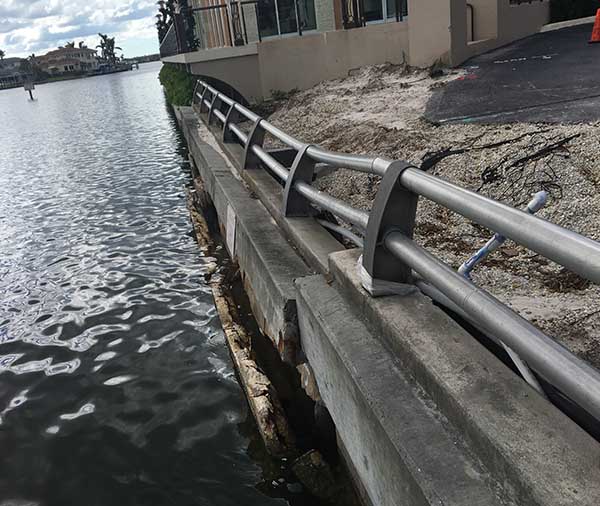Seawall cap cracks and fissures are not only a tripping hazard, but the cracks in your concrete cap can immensely compromise the integrity of your seawall.
Coastal concrete structures can last 40 to 50 years, but sooner or later, most seawalls caps end up developing small cracks, fissures and crevices. If your concrete seawall cap has begun to show its age, make the necessary repairs sooner rather than later. In the end, a minor and insignificant problem today is only going to get bigger and more extensive (And Expensive) to repair.
The concrete seawall cap surrounding and encompassing your seawall/bulkhead supports and sustains the entire integrity of the seawall itself. So, it’s quite natural to be alarmed if you ever encounter fractures and crevices in the concrete seawall cap. Fortunately, many small fissures in your concrete cap are not serious enough to warrant professional attention. However, in many circumstances a foundation crack can be serious risk as it can threaten the structural integrity of the seawall. The best way to safeguard that a crack doesn’t indicate a major issue is to have a licensed marine contractor or a structural engineer take a look and give their professional advice.
Horizontal cracks in your seawall cap often reveal a critical problem that requires immediate attention. They are caused by hydrostatic (water) pressure from the inside of the walls and can lead to a failure in the seawall structure if not addressed. This situation usually entails the corrosion of the concrete and exposed reinforcing steel (rebar), which ultimately weakens the wall significantly and oftentimes results in a catastrophic failure of the seawall.


Frequently, a diagonal or vertical crack in your seawall foundation cap is the result of settling in the concrete seawall slabs and is quite common in seawall construction. Concrete shrinks while it cures, these cracks are termed shrinkage cracks. They usually run vertically or diagonally and are often positioned in the top section of walls. Shrinkage cracks are typically 1/8 in wide.
Be aware that concrete does in fact expand and contract, especially during hot summer months and when Florida’s afternoon thundershowers reduce the temperature on the concrete, it moves dramatically. If the crack is located closer to an edge or corner and is wider than 1/2 in, it is probably not due to shrinkage but indicates a more serious seawall foundation issue.
Once a crack is large enough to insert a nickel, you may have a seawall foundation problem and should invest in structural repairs. One of the advanced methods utilized for crack restoration is an Epoxy injection technique. The system process fuses and welds the crack back together in a short duration of time. It restores the previous strength and loading capacity of the original concrete cap or wall. Epoxy injections also restore the design and structural integrity, making the concrete seem as good as new. The epoxy seal makes the foundation impervious to water, harmful chemicals, debris, and other contaminants. The Epoxy injection process is used for cracks as narrow as 0.002 inch. The approach generally consists of creating an entry point, inserting venting ports at nearby intervals along the cracks, sealing the crack of exposed surfaces, and injecting the epoxy under low pressure.


Epoxy injection has been extensively utilized in the repair of cracks and fissures in structural concrete marine foundations and seawall caps. Bridge structures, dams, commercial buildings, and a variety of concrete structures have been revitalized using this modern technique. However, unless the cause of the cracking has been corrected, it will probably reoccur near the original crack. If the cause of the cracks cannot be removed, there are several additional options are available.
One option is to verify a joint that will accommodate the movement and then inject the crack with epoxy. Sometimes filling horizontal cracks and repairing other cosmetic problems simply isn’t enough. They won’t solve the underlying issues of a failing seawall cap foundation.
High Pressure Injection is typically used on horizontal and diagonal cracks where established repair methods cannot penetrate and deliver the product into the crack.
Prior to progressing with a crack repair by epoxy injection, the cause of the crack and the need for a structural repair must be established. If the crack does not compromise the structural integrity of the seawall/bulkhead, injection with polyurethane grouts or other nonstructural materials may be a more suitable choice to fill the crack. When a structural repair is required, conditions that cause the crack must be corrected prior to proceeding with the epoxy injection.
This method involves inserting a liquid at a very low pressure into a narrow crack (more than 1/16″). Low-pressure injection utilizes the gravity principle rather than the high-pressure principle itself, since the pressure used is around 45 psi. This procedure is mainly suitable in the case of epoxy injection for non-structural cracks, inherent to structures that must retain their architectural features and visual appearance.
Questions about your seawall repair options? Contact our office today for a FREE estimate. We welcome the opportunity to review your seawall needs and earn your business!
(239) 284-6830